How to create PowerPoint templates that work
Without a proper PowerPoint template, presentations can be a bit of a mess. Here are the building blocks for developing a PowerPoint template that works!

Sometimes when you’re presenting, it’s useful to give people handouts to annotate notes on the slides and jot down a few thoughts while you’re speaking. A good way to do this is to print multiple slides on one page, so they’re not dealing with reams of paper. It also encourages your audience to just take a few notes, rather than anything too detailed where they could miss something important.
What’s the secret for how to print multiple slides on one page?
In PowerPoint there is a specific view called Handouts which allows you to print multiple slides on one page. Handouts not only gives you options for how many slides to include on each page, but you can create special formatting to make the final print out look more professional and in keeping with your brand.
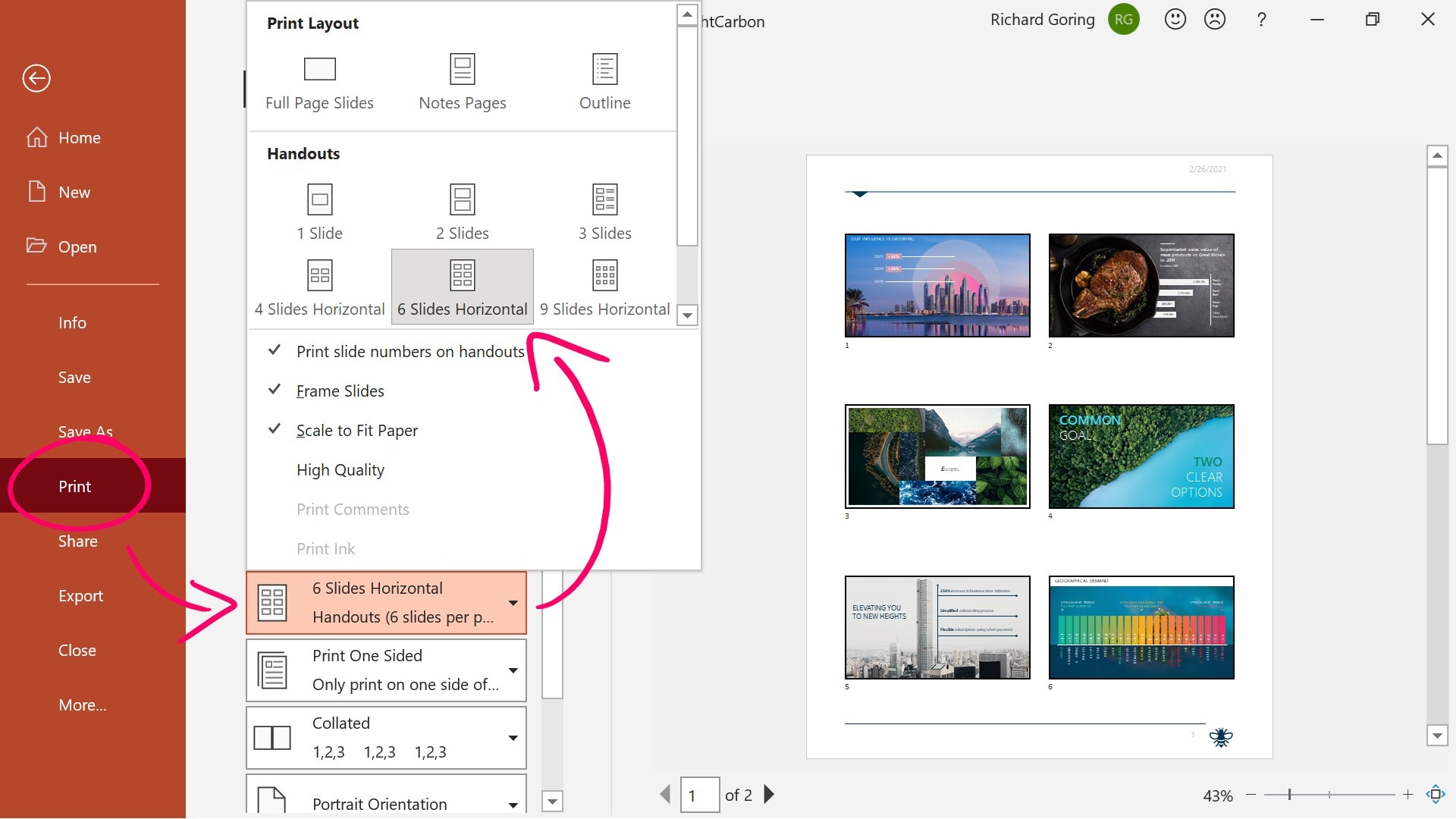
PowerPoint handouts allow you to print multiple pages on one page. Go to the File tab in the top left of the ribbon (or use Ctrl +P), and choose Print on the left. In the new view that appears, under Settings, you’ll find options for which slides to print, and then the Print Layout options. Choosing this drop-down menu (labelled as Full Page Slides initially) gives you access to the options of what to print, and here you can choose Handouts, giving you the option to print multiple pages on one page. You can choose 1, 2, 3, 4, 6, or 9 slides to be laid out in a grid across the page, and with some you can choose whether the slides are ordered in rows (horizontal) or columns (vertical).
You can also choose whether the Print slide numbers on handouts, Frame Slides with a dark outline, Print Comments (if there are any), and Print Ink on the slides (the PowerPoint drawing tools that some people use to comment or mark up slides).
There’s an interesting option to Scale to Fit Paper, which can be frustrating. The viewable PowerPoint handouts page size is 7.5” wide by 10” tall. This assumes a 0.5” print border on all sides (making it standard letter size of 8.5”x11”). But modern printers can do better, so selecting scale to fit paper will stretch the handouts page to the maximum print area your printer can manage. Either way, you’ll likely see some form of additional space around your handouts page when printing, unless you print to PDF, which has no margins and the handouts page will look as it does in PowerPoint.
If you go back up to the top, you can choose the printer to use, which is where you’ll find the option to create a PDF of multiple slides on one page, in whichever Handouts configuration you’ve chosen.
In this print view, you can also choose whether to print one- or two-sided, whether to collate the print-outs, and if you want to print in color, grayscale, or black and white.
That’s how to print multiple pages on one page, but it won’t look great. Fortunately, there are some options to customize how it all looks, which may be worth setting up to make things look more professional, more accessible, or both.
Print multiple slides on one page that look good with the Handouts Master
Problems with PowerPoint handouts
How do you print 3 slides per page handout without lines
How to print multiple slides on one page with Word
How to create custom handouts in PowerPoint
How to create customer handouts in PowerPoint with Zoom
How to create custom handouts in PowerPoint with add-ins
By default, printing multiple slides on one page looks pretty basic. It’s just the slides on a blank page. But with the Handouts Master you can customize the formatting and add other elements to the pages in a dedicated view that doesn’t impact your presentation slides. To do this go to the View tab on the ribbon and choose Handouts Master on the left. This brings up a new view where you can start to make changes to the style of the handouts you create.
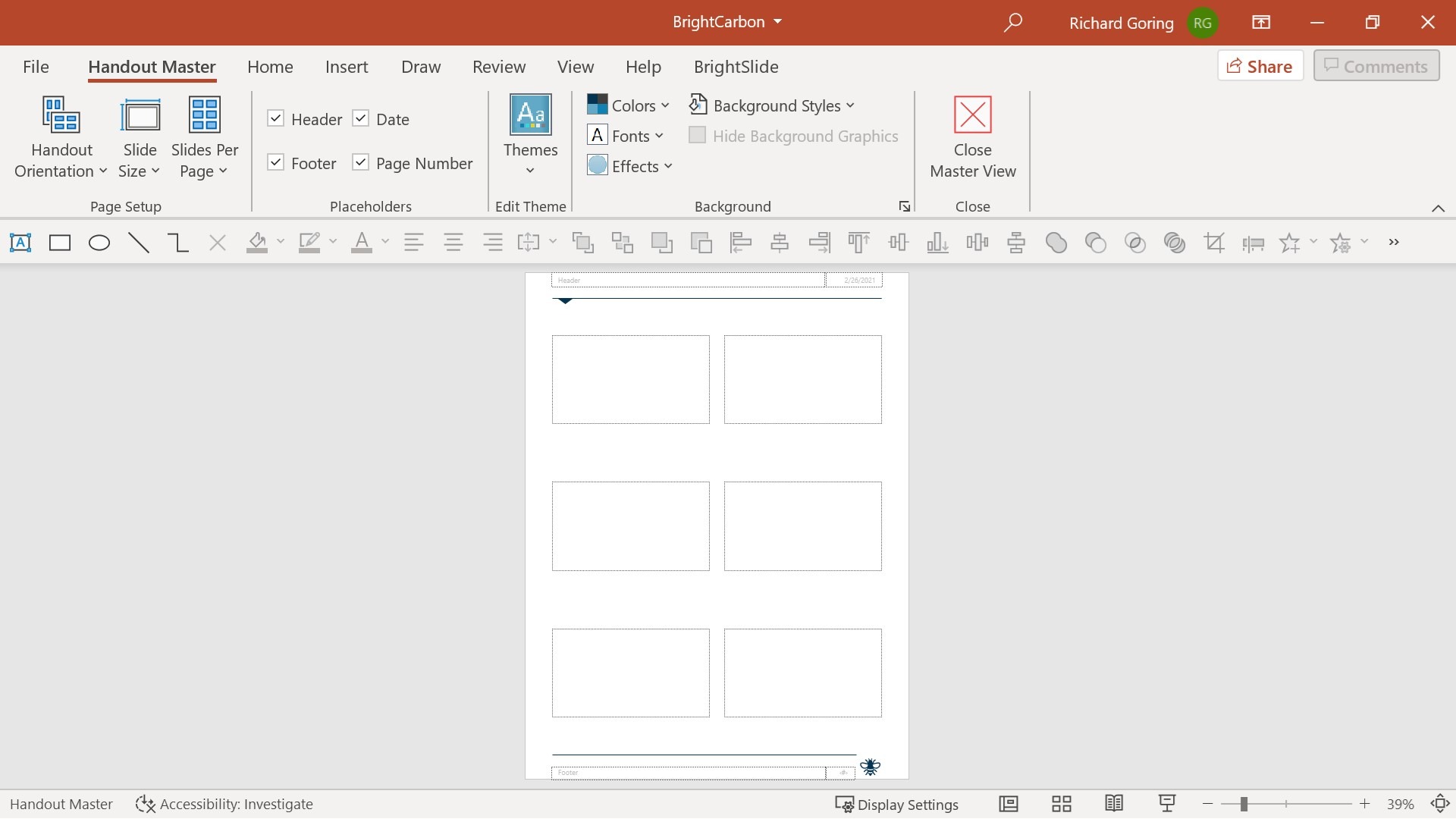
Starting on the left, you can alter the page orientation – either portrait or landscape – which impacts how things will print. But don’t be fooled by the slide size option next to it, as this alters the aspect ratio of your presentation slides, not the whole handouts page to be printed, which is really confusing. The page size for the handout is determined by your printer’s paper size setting. To change that, use Ctrl + P to go to the print options, under Printer in the top left choose Printer Properties, which will bring up the options for your printer. Somewhere in that menu (or series of menus), you’ll find the paper size options. Changing the paper size changes the size of the page you have to work with. Not at all confusing, is it?
Back to the Handouts Master view, on the left there is also an option to choose how many slides are on each page. You can’t change the position or size of these, but it does highlight where the slide thumbnails will be, showing you where can add additional content, graphics, and branding to the overall handouts page.
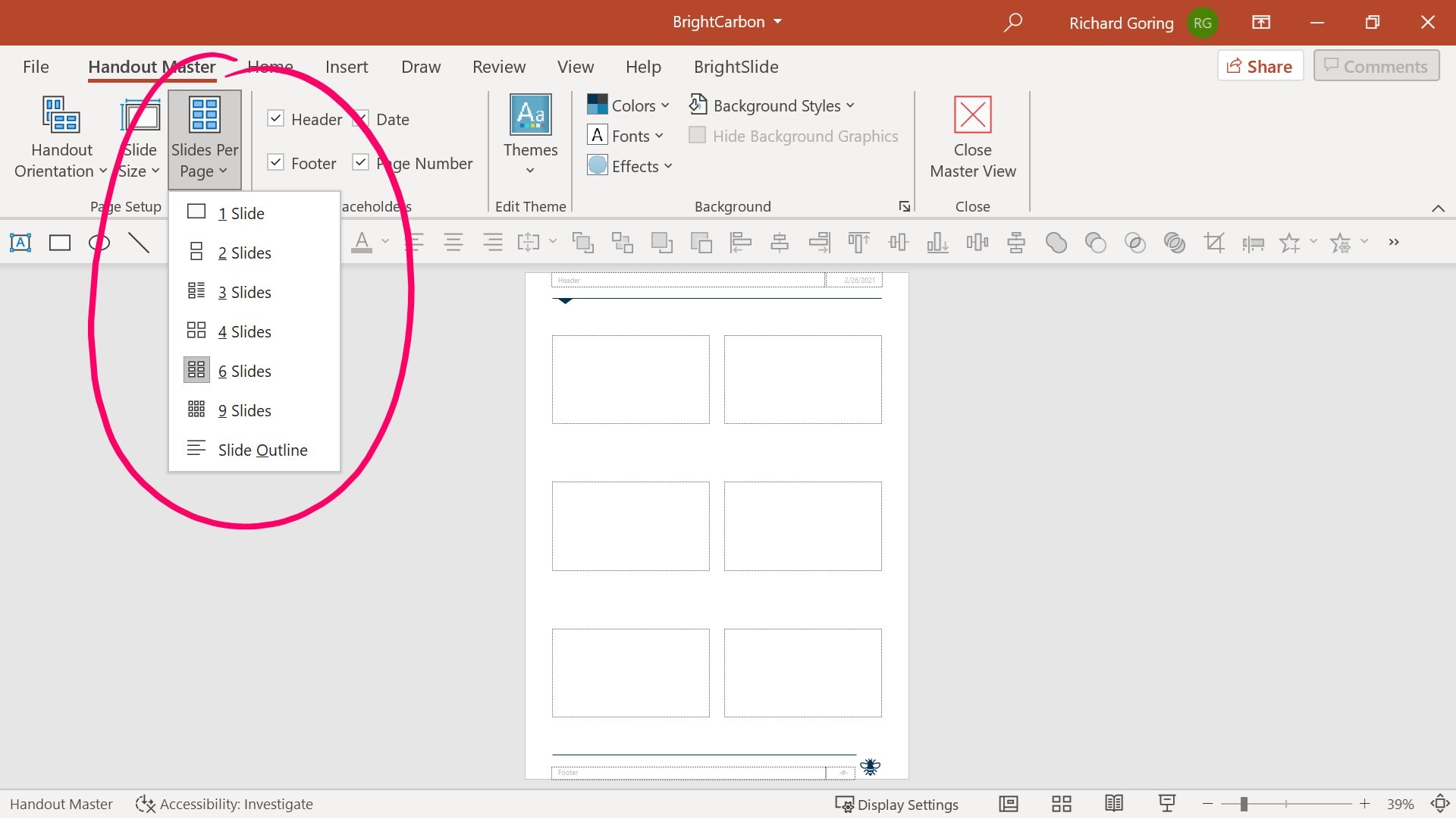
There are four placeholder elements you can add – Header, Footer, Date, and Page Number. These are all elements that are applied globally across all handouts pages, but you can customize them, changing the size, position, and formatting by clicking on any of the elements on the master handouts page itself, or adding/removing them using the check boxes in the ribbon.
To actually add content to the Header or Footer, or show any of these four placeholders on the handout pages you print, go to the Insert tab on the ribbon and choose Header & Footer over on the right. This brings up a new pop-up window, but carefully note the small tab at the top, as there are two sets of header and footer options here – one for the actual presentation slides, and one for the handouts where there are multiple slides on one page. Choose the Notes and Handouts tab, and there you can choose which of the elements to include, and what the content of the Header or Footer placeholders will be.
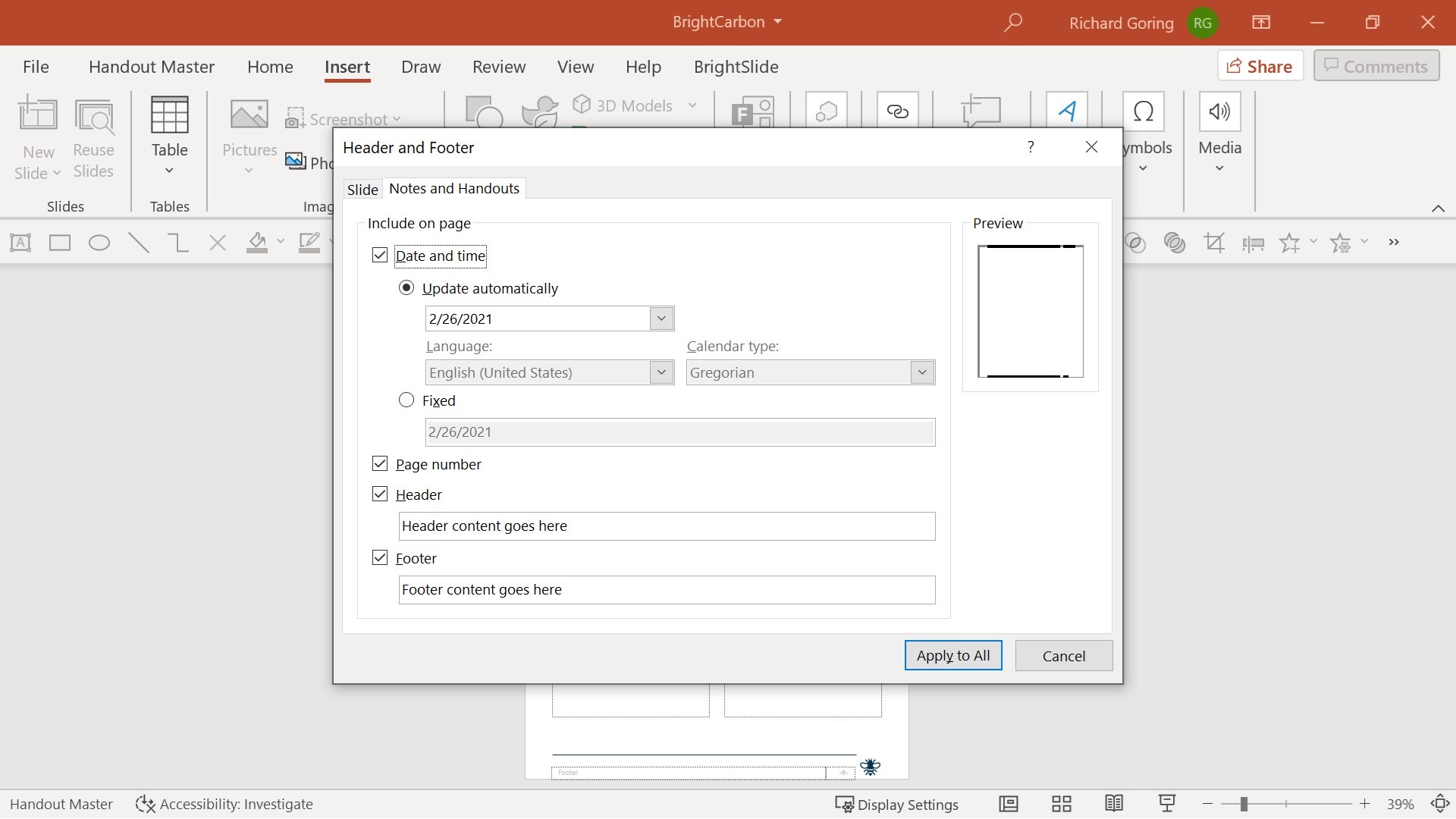
Finally, you come to the formatting options. In the ribbon, you can set the theme, which includes colors and fonts. I recommend you do this, as the Handouts view does not pick up theme colors from the presentation slide view. It’s easy to import the color theme from your presentation. The same goes for fonts too.
In addition to the theme formatting, you can also format the page itself, by adding images, graphics, and other content. Just make sure they don’t interfere with the slide thumbnails. When you want to print multiple slides on one page, the slides will always appear on top of any content or graphics you’ve added to the Handouts Master page, so you do have a bit of artistic license to create large background graphics that the slides will sit on top of. It also means that you don’t need to worry too much if people change the number of slides per page. That said, in general, simple may be better.
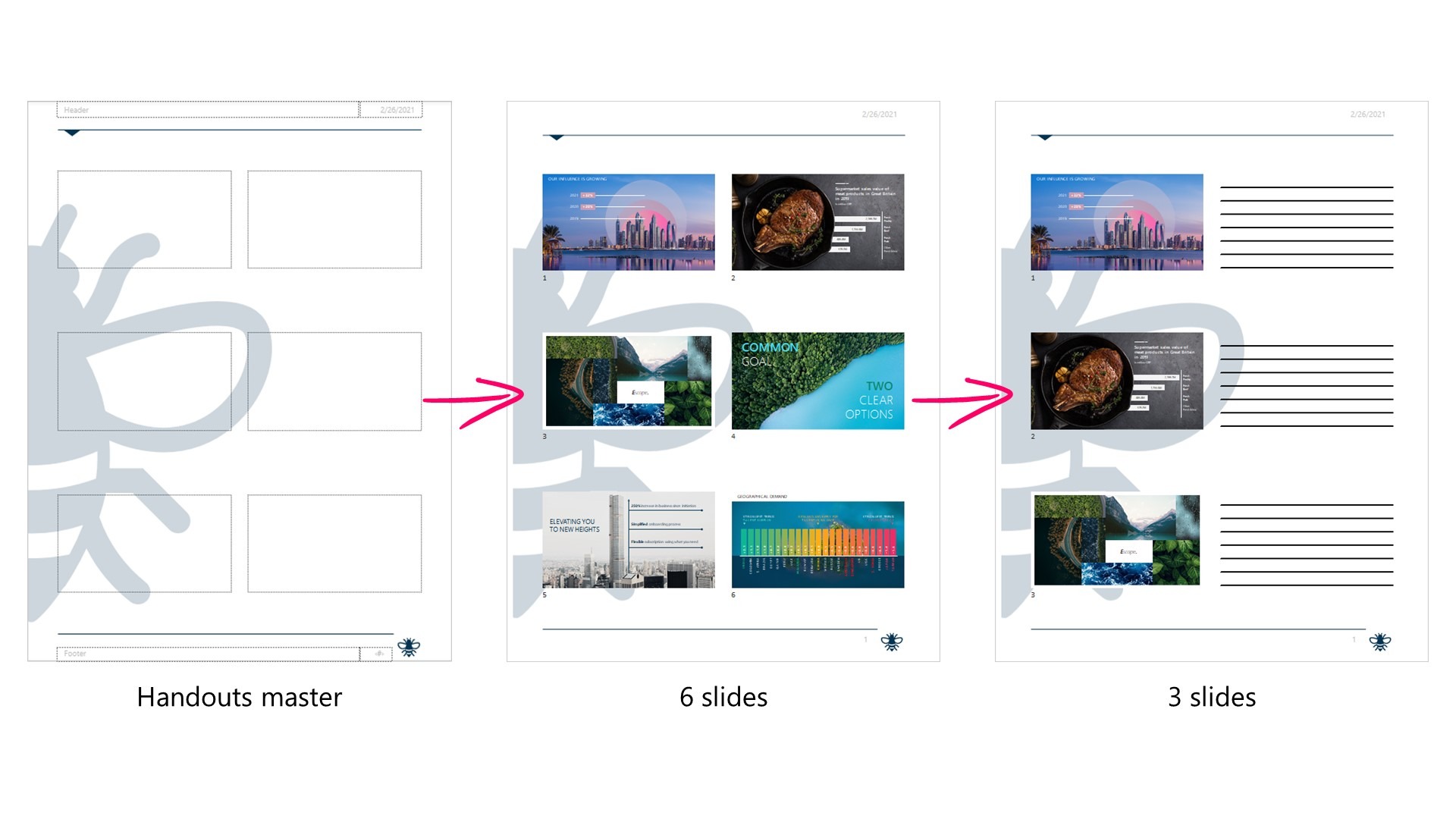
The Handout pages in PowerPoint are pretty similar to the Notes pages. So whether you’re trying to print multiple pages on one page or print PowerPoint with notes, you’ll be using the same mechanism. That means that there are a few problems it’s worth knowing about including the lack of hyperlinks, page size being an issue, print setup causing problems, and the woeful lack of guides across the entire page. You can read more about the problems with PowerPoint handouts here.
One of the handout layouts is 3 Slides, which gives you three slides on the left and then lines for writing notes on the right. This is great usually, but you can’t turn them off. And because anything you put on the handouts master will always appear underneath the slides and the lines, you can’t mask them. There are some hacks, which are a bit more involved, so if you’re really keen you could try using Word or creating custom handouts in PowerPoint or using add-ins, which you can read more about below.
You can create handouts in Word using PowerPoint and this gives you the ability to customize your handouts further. Do this is:
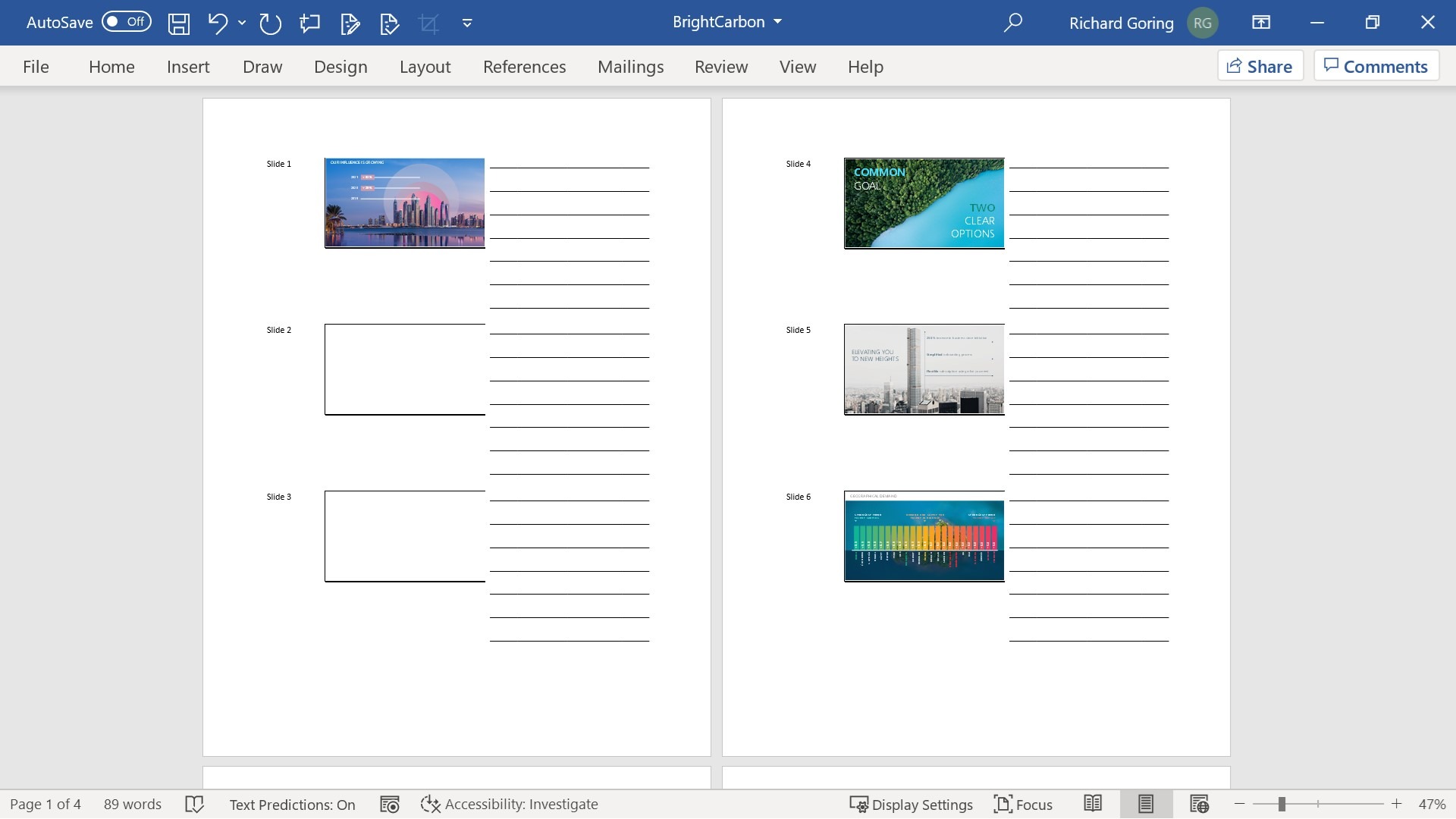
This generates a Word document with a long table in it. Now if there are two things you don’t want to hear together, it’s tables and Word, but this is what you have to work with. As it’s in Word, you can edit the content, so you can remove all of the lines next to the slides. You can change the sizing of the slides and cells in the tables, so that you can fit four slides per page on the left with space to the right. You can adjust the margins in Word so that the slides cover more of the page. Essentially you have much greater control over where everything is, and while you have to manipulate a table in Word to do it, if you select the entire table changes to one cell should impact all others and so all pages in the handout.
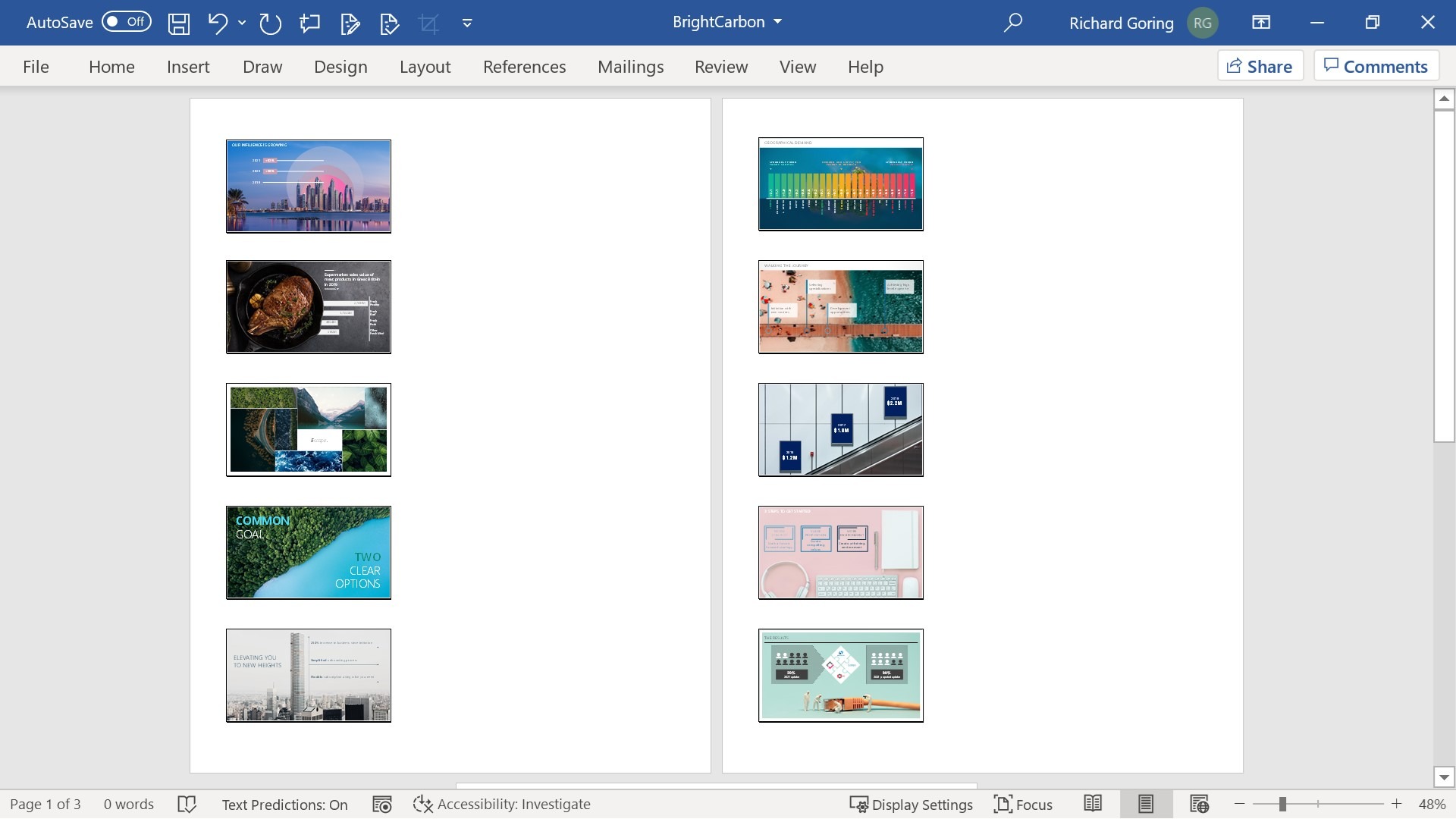
It’s not ideal though. Not only because it’s a table, but because it’s really slow. Word just doesn’t seem built to handle this format, so changes are made at a glacial pace, and even just generating it in the first place feels like it should have a horrible modem screeching sound accompanying it. This may be because the file size is huge. A 27MB PowerPoint file turned into a 101MB Word file. This may be because the slides aren’t pictures, but objects, so they are a live representation of the slides in the PowerPoint file, including all the high resolution images and even videos that you don’t need in a handout.
What is nice about it is that because the slides are real PowerPoint slides, if you change the presentation, the slides in the Word handout will update automatically.
You could create a custom handout to print multiple slides on one page by saving each of the slides as images and then arranging them on a slide as you want. You can use the free BrightSlide add-in to save all the slides (or selected slides) in your deck as an image, and even choose the size, so that the handout file size isn’t too large. But then you’ve got to create the document. You could create a custom layout in the slide master so that you can easily drop the images in, but there is still the issue of version control and how slides can get outdated.
You could then go the trouble of creating separate handout file and then copy/paste each individual slide as a Microsoft PowerPoint Slide Object, which you’ll find in Home > Paste > Paste Special > Microsoft PowerPoint Slide Object. This is what happens when you export handouts to Word, and it’s also a pain to do. But the slides in the handout will update if they change in the presentation, and you can create custom page sizes and formatting.
However, a neat hack could be to use the Zoom link function in PowerPoint to create a series of live slide thumbnails that you can then arrange into a suitable custom handout in PowerPoint where you can control the size and position of the slide thumbnails, the number of them per slide, the arrangement, and add any custom elements you want that will help, such as a key takeaway box. If anything changes on the slide, then the thumbnail will get updated. It doesn’t add anything to the file size and it’s all in the same file, which is great for version control and availability.
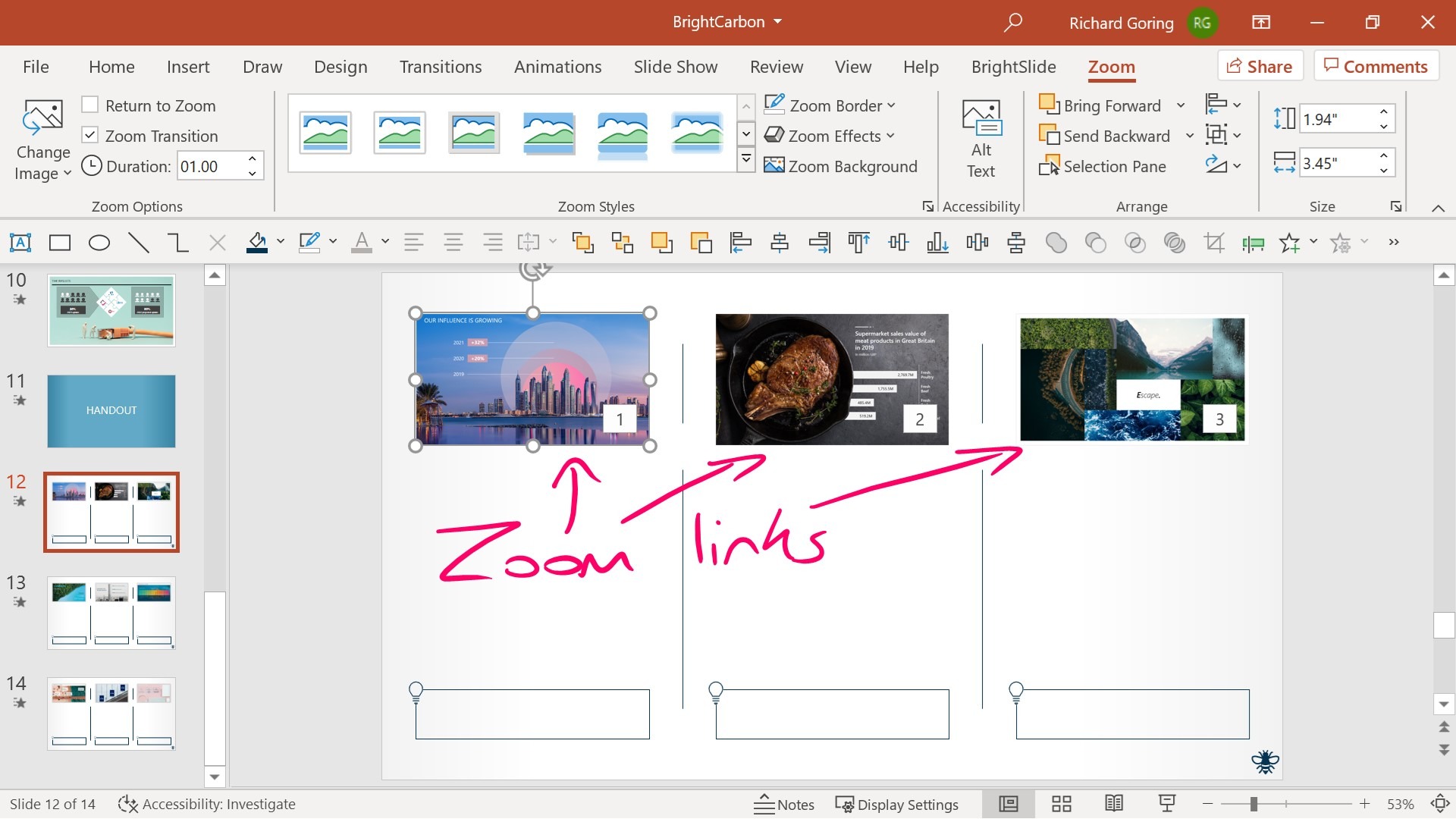
It does mean your page size is the same as the slide size though, so actual printing may be awkward, but sharing as a PDF is likely fine, as it will be viewed on a screen that is almost certainly widescreen 16:9 too.
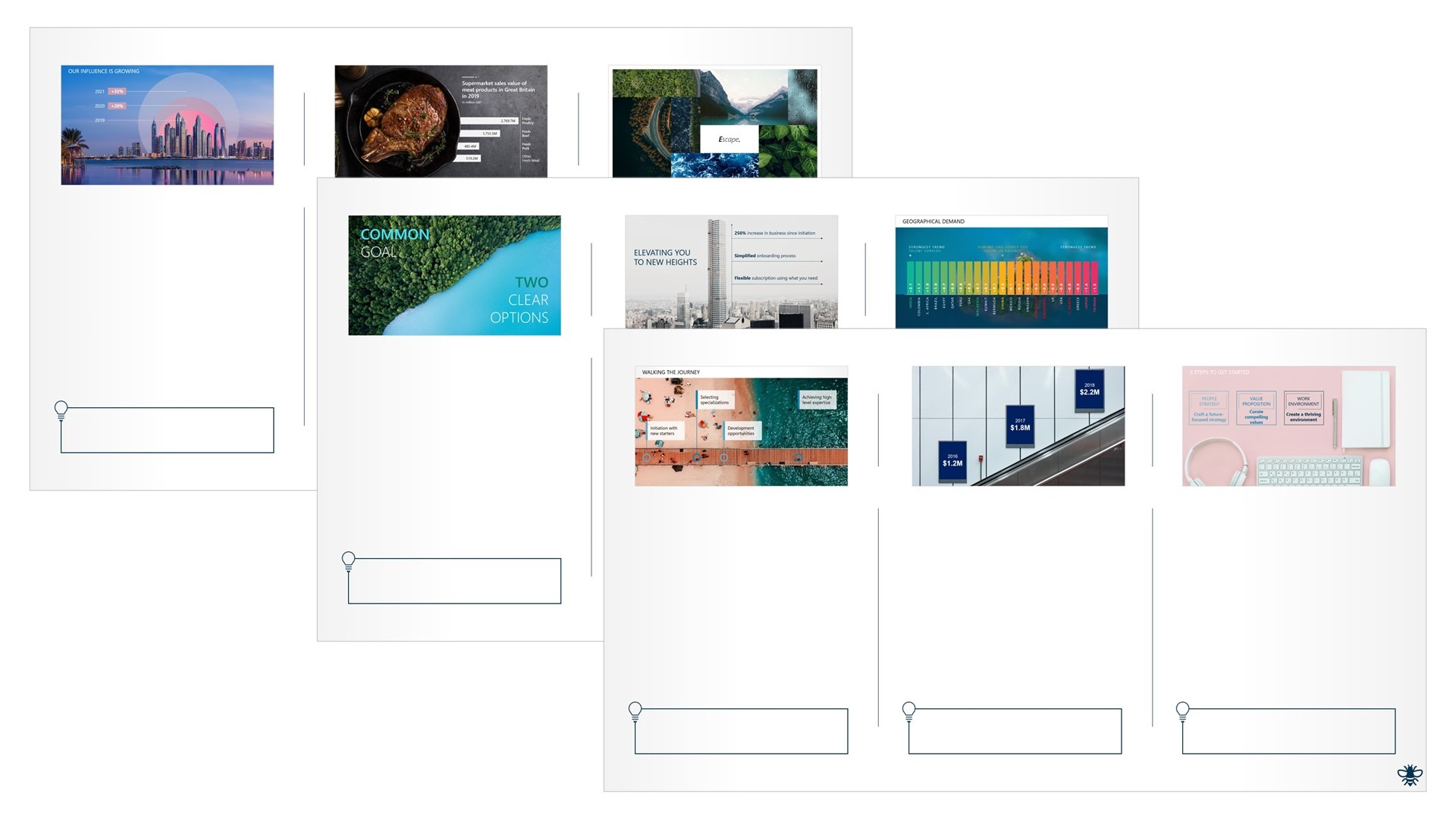
Whatever your views on the pros and cons, it’s extra effort that you may not want to put in, so there are some neat tools that allow you automate the process of creating custom presentation handouts in PowerPoint that allow you print multiple slides on one page.
Our free BrightSlide add-in will get you part of the way there, as I mentioned above, but Rich Michaels from Great Circle Learning has developed the george! add-in, which gives you a great many options to print multiple pages on one page, with different layouts, formatting, and resolution settings. You can even add a table of contents automatically if you’d like.
Another option, that’s a bit cheaper, but also older is the Handout Wizard add-in from the excellent Shyam Pillai. Again, this gives you a plethora of options for different layouts for your handouts. Both offer a free trial, so you can try them out and see if they work for you.
Alternatively, why not try creating completely custom content to support your presentation, to make even better handouts.
Leave a commentWithout a proper PowerPoint template, presentations can be a bit of a mess. Here are the building blocks for developing a PowerPoint template that works!
By applying some key principles of presentation design, you can make your PowerPoint design really standout and deliver both a more ‘popping’, but also more effective presentation.
Most presentations are a cascade of text-heavy Death-by-PowerPoint slides. Online learners suffer the torture of brochures converted to click-through-eLearning. Most people now recognize that using visuals is the way to go. But how do you make visual presentations and eLearning that work? We think there are six steps you need to follow.
Join the BrightCarbon mailing list for monthly invites and resources
Tell me more!We have worked with BrightCarbon for over 5 years, across a number of healthcare divisions, where they have been a very important part of our bid programme, supporting numerous awards of new contracts.
Sarah Appleton Brown Practice Plus Group
